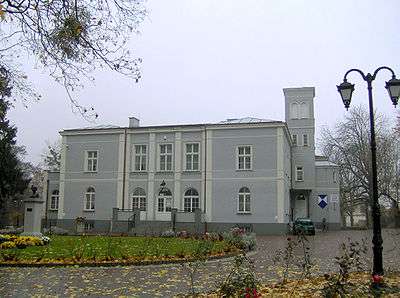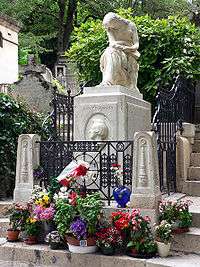Memorials to Frédéric Chopin
The following is a compilation of memorials to the composer Frédéric Chopin in the form of physical monuments and institutions and other entities named after him.
Chopin's Polish residences

Fryderyk Chopin's principal Polish residences survive — most of them rebuilt from the devastations of World War II — except for the Saxon Palace, where his father Mikołaj Chopin in October 1810 (when Fryderyk was six months old) took a post teaching French at the Warsaw Lyceum, housed in the Saxon Palace. The Chopin family lived on the premises.
In 1817 the Saxon Palace was requisitioned by Warsaw's Russian governor for military use, and the Warsaw Lyceum was reestablished in the Kazimierz Palace (today the rectorate of Warsaw University).[1] Fryderyk and his family moved to an extant building (center photo, below) adjacent to the Kazimierz Palace.
In 1827, soon after the death of Chopin's youngest sister Emilia, the family moved from the Warsaw University building adjacent to the Kazimierz Palace, to lodgings just across the street from the university, in the south annex of the Krasiński Palace on Krakowskie Przedmieście. Chopin lived there until he left Warsaw in 1830. The Krasiński Palace is now the Warsaw Academy of Fine Arts.
Chopin's Żelazowa Wola birthplace, and the Chopin family parlor in Warsaw's Krasiński Palace, are maintained as museums open to the public.
The Saxon Palace was destroyed by the Germans in World War II. Plans have been put forward to rebuild it. It was in the Saxon Palace (at the time, the Polish General Staff building) that civilian mathematicians working at the General Staff's Cipher Bureau, beginning in 1932, broke Germany's Enigma machine ciphers—an achievement that would be of great importance to the outcome of World War II.[2]
- Some of Chopin's Polish residences
-

Chopin's Żelazowa Wola birthplace. He lived here for six months in 1810.
-
Warsaw University building where Chopin's family lived, 1817–27, now embellished (center) with bas-relief of his profile
-
Chopin family parlor, in Warsaw's Krasiński Palace. Chopin lived here, 1827–30.
Physical monuments
Europe
France
- Chopin's tombstone in Père Lachaise Cemetery, Paris, featuring the muse of music, Euterpe, weeping over a broken lyre, was designed and sculpted by Auguste Clésinger. A monument to Chopin can also be found in Paris's Parc Monceau.
Poland
- Chopin's heart, preserved in alcohol,[3] was sealed in 1882 within a pillar of the Holy Cross Church, behind a tablet carved by Leonard Marconi.[4] The tablet bears an inscription from Matthew VI:21: "For where your treasure is, there will your heart be also."[5] (See photo of the Church pillar, with epitaph.)
- The Holy Cross Church stands only a short distance from Chopin's last Warsaw residence, the Krasiński Palace, which bears a plaque commemorating Chopin.
- There is a monument to Chopin at the Szafarnia manor house where he stayed for holidays with a schoolfriend in 1824 and 1825.
- In 1926 a bronze statue of Chopin, designed by sculptor Wacław Szymanowski in 1907, was erected in the upper part of Warsaw's Royal Baths (Łazienki) Park.
- Other statues and busts of Chopin stand in Bydgoszcz, Poznań, Wrocław and Żelazowa Wola.
- For the 2010 bicentennial of Chopin's birth, 14 "Chopin's Warsaw" ("Warszawa Chopina") benches were placed in Warsaw near Chopin landmarks. Pressing a button on a bench makes it play a few bars of a Chopin composition.[6]
North America
- The Chopin Theatre, Chopin Park, Chopin School, and Chopin Plaza,[7] in Chicago are all named in the composer's honor, a testament to the influence of Chicago's Polish Community. A Chopin statue is planned for Chicago's lakefront.[8]
List of cities with monuments to Chopin outside of Poland
Asia
Europe
North America
South America
- Chopin monuments
-
Plaque (placed in 2010, on Chopin's 200th birth anniversary) commemorating the 8-year-old's first public performance, in today's Presidential Palace, Warsaw, for the Warsaw Philanthropic Society, 24 February 1818
-

General Dominik Dziewanowski's Szafarnia manor (with Chopin's bust in front) where Chopin vacationed in 1824 and 1825; now a Chopin Center
-

Chopin's grave at Père Lachaise Cemetery
-
Funerary monument on a pillar in Holy Cross Church, Warsaw, enclosing Chopin's heart (just above bouquet at bottom)
-
.jpg)
Chopin statue, Łazienki Park, Warsaw
-

Ostrogski Palace, Warsaw home of the Fryderyk Chopin Museum
-
"Chopin's Warsaw" bench: one of 14 created for his 2010 birth bicentennial. They stand near Chopin landmarks such as the Krasiński Palace, the Carmelite Church where he played organ as a boy (this photo), and the Wessel Palace where in 1830 he boarded a stage for Vienna. Pressing a button makes bench play a few bars of a Chopin composition.
Musical homage
- Sergei Lyapunov, Żelazowa Wola, Op. 37, a symphonic poem composed in 1909 to commemorate Chopin's birth centenary the following year.
Musical institutions
- The largest Polish music conservatory is named Fryderyk Chopin University of Music.
- The world's oldest monographic music competition, the International Chopin Piano Competition, founded in 1927, is held every five years in Warsaw. Periodically the Grand prix du disque de F. Chopin is awarded for notable Chopin recordings.
Chopin societies
Museums
- The Fryderyk Chopin Museum, established in 1954, is housed in Warsaw's Ostrogski Palace, seat of the Fryderyk Chopin Society. The Museum was refurbished in 2010 for the 200th anniversary of Chopin's birth.
- Chopin's Birthplace in Żelazowa Wola is operated as a museum by the Fryderyk Chopin Museum.
- The Museum also maintains the Chopin Family Drawing Room in the Krasiński Palace, Warsaw.
- Salon Frédéric Chopin, Paris
- Cell no. 4, Valldemossa Charterhouse, Majorca - the rooms where Chopin and George Sand stayed are laid out as a museum, including Chopin's Pleyel piano.
- The Polish Library in Paris houses a permanent exhibition, the only one in France, dedicated to the composer.[12]
Other
Named for the composer are:
See also
Notes
- ↑ Fryderyk Chopin Information Centre.
- ↑ Harry Hinsley, "The Influence of ULTRA in the Second World War" (transcript of a lecture given on 19 October 1993 at Cambridge University), 1996 .
- ↑ Samson (1996), 193.
- ↑ Holy Cross Church (Kościół Św. Krzyża) on Inyourpocket.com website, accessed 7.12.2013
- ↑ Zdzisław Jachimecki, "Chopin, Fryderyk Franciszek", Polski słownik biograficzny, vol. 3, Kraków, Polska Akademia Umiejętności, 1937, pp. 424–25.
- ↑ "Walking Around Chopin's Warsaw (Chopin's Benches", Visit Chopin in Warsaw website, accessed 6 August 2013.
- ↑ http://www.dnainfo.com/chicago/20140626/gladstone-park/gladstone-park-plaza-be-renamed-for-chopin
- ↑ http://www.chopinmonumentinchicago.com/index.php
- 1 2 3 4 http://bazawiedzy.chopin2010.pl/en/places/chopin-locations-today/world.html
- ↑ http://www.polishheritage.co.uk/index.php?option=com_content&view=article&id=143:unveiling-chopin-monument-at-manchester-sept-2011&catid=57:archived-news&Itemid=160
- 1 2 3 4 "Exploring South America". Warsaw Voice. 3 July 2003. Retrieved 24 January 2015.
- ↑ Website of the Bibliothèque Polonaise de Paris (in French).
Sources
- Samson, Jim (1996). Chopin. Oxford: Oxford University Press. ISBN 978-0-19-816703-7.